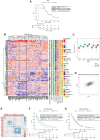CCNE1 and PLK1 Mediate Resistance to Palbociclib in HR+/HER2- Metastatic Breast Cancer
- PMID: 36749874
- PMCID: PMC10102847
- DOI: 10.1158/1078-0432.CCR-22-2206
CCNE1 and PLK1 Mediate Resistance to Palbociclib in HR+/HER2- Metastatic Breast Cancer
Abstract
Purpose: In hormone receptor-positive (HR+)/HER2- metastatic breast cancer (MBC), it is imperative to identify patients who respond poorly to cyclin-dependent kinase 4/6 inhibitors (CDK4/6i) and to discover therapeutic targets to reverse this resistance. Non-luminal breast cancer subtype and high levels of CCNE1 are candidate biomarkers in this setting, but further validation is needed.
Experimental design: We performed mRNA gene expression profiling and correlation with progression-free survival (PFS) on 455 tumor samples included in the phase III PEARL study, which assigned patients with HR+/HER2- MBC to receive palbociclib+endocrine therapy (ET) versus capecitabine. Estrogen receptor-positive (ER+)/HER2- breast cancer cell lines were used to generate and characterize resistance to palbociclib+ET.
Results: Non-luminal subtype was more prevalent in metastatic (14%) than in primary tumor samples (4%). Patients with non-luminal tumors had median PFS of 2.4 months with palbociclib+ET and 9.3 months with capecitabine; HR 4.16, adjusted P value < 0.0001. Tumors with high CCNE1 expression (above median) also had worse median PFS with palbociclib+ET (6.2 months) than with capecitabine (9.3 months); HR 1.55, adjusted P value = 0.0036. In patients refractory to palbociclib+ET (PFS in the lower quartile), we found higher levels of Polo-like kinase 1 (PLK1). In an independent data set (PALOMA3), tumors with high PLK1 show worse median PFS than those with low PLK1 expression under palbociclib+ET treatment. In ER+/HER2- cell line models, we show that PLK1 inhibition reverses resistance to palbociclib+ET.
Conclusions: We confirm the association of non-luminal subtype and CCNE1 with resistance to CDK4/6i+ET in HR+ MBC. High levels of PLK1 mRNA identify patients with poor response to palbociclib, suggesting PLK1 could also play a role in the setting of resistance to CDK4/6i.
©2023 The Authors; Published by the American Association for Cancer Research.
Figures





References
-
- Gao JJ, Cheng J, Bloomquist E, Sanchez J, Wedam SB, Singh H, et al. . CDK4/6 inhibitor treatment for patients with hormone receptor–positive, HER2-negative, advanced or metastatic breast cancer: a US food and drug administration pooled analysis. Lancet Oncol 2020;21:250–60. - PubMed
-
- Turner NC, Ro J, André F, Loi S, Verma S, Iwata H, et al. . Palbociclib in hormone receptor–positive advanced breast cancer. N Engl J Med 2015;373:209–19. - PubMed
-
- Slamon DJ, Neven P, Chia S, Fasching PA, De Laurentiis M, Im S-A, et al. . Phase III randomized study of ribociclib and fulvestrant in hormone receptor–positive, human epidermal growth factor receptor 2—negative advanced breast cancer: MONALEESA-3. J Clin Oncol 2018;36:2465–72. - PubMed
-
- Sledge GW, Toi M, Neven P, Sohn J, Inoue K, Pivot X, et al. . MONARCH 2: abemaciclib in combination with fulvestrant in women with HR+/HER2- advanced breast cancer who had progressed while receiving endocrine therapy. J Clin Oncol 2017;35:2875–84. - PubMed
Publication types
MeSH terms
Substances
LinkOut - more resources
Full Text Sources
Medical
Molecular Biology Databases
Research Materials
Miscellaneous

